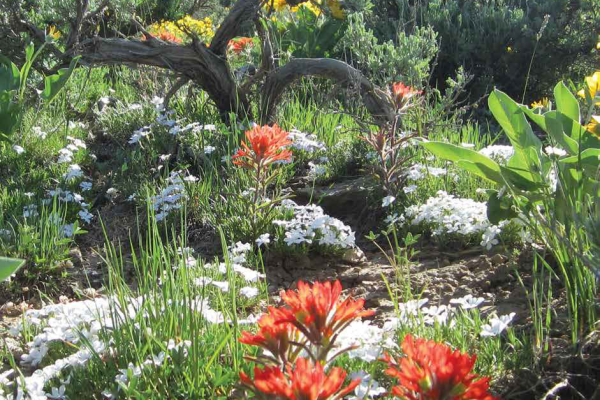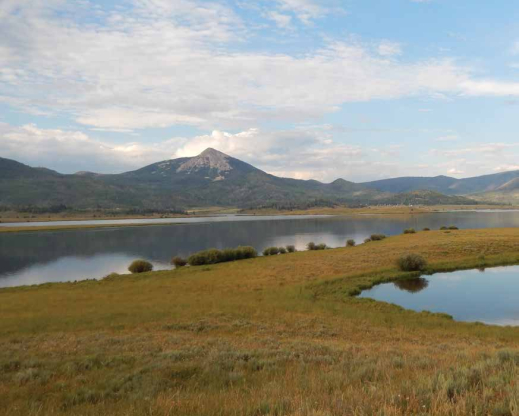Historic steamboat springs, Colorado, is located about 170 miles northwest of Denver in a botanical paradise. Elevations in the region range from 6,000 feet to over 12,000 feet, taking in almost the full spectrum of life zones found in Colorado. The only one missing is short grass prairie, which in this part of the state is replaced by sagebrush steppe. In the summer it is possible to start in sagebrush steppe and hike your way up through all the life zones to the alpine in one day. It is not surprising that with so much diversity in landscapes and habitats a wide range of vascular plants call northwest Colorado home. Long known to botanists for an array of flora disjunct from the Pacific Northwest in the cool and moist Park Range to several possible endemics of middle elevations, and a rich steppe and meadow flora encompassing both wide-ranging species and regional endemics, few areas of Colorado can show off such floral diversity.
The past four NARGS Annual Meetings in Colorado in 1986, 1993, 2003 and 2010 centered around alpines and rock gardening and focused on the rich and interesting Front Range and the central Rockies of the state with their rich alpine, subalpine and montane floras. The area around Steamboat Springs, venue for the 2016 meeting, is a bit different: the mountains tend to be a bit lower, none are over 12,400 feet, and they are a bit more gentle. The high alpine areas tend to be accessible only to hikers, meaning they are often full of solitude and wide open vistas over the steppes and lower mountains of northwest Colorado and southern Wyoming. Depending on snow conditions we may have a few hikes going up into the subalpine/alpine areas of the Flattops; however, most of the hikes and trips will focus on elevations ranging from the rich and varied steppe flora up into the interesting montane and subalpine areas. Variable winter snowfall, snowpacks, and upredictable spring meltouts (even more possible and unpredictable in the last 10 years) make it difficult to predict what exactly will be in bloom the last weekend of June 2016, but in general Steamboat Springs could easily challenge Crested Butte as the “Wildflower Capital of Colorado,” and probably exceed it in variety.
Below is an introduction to some of the mountain ranges and areas around Steamboat Springs. Watch for individual articles leading up to the meeting covering various aspects of these special areas.
Park RangeThis north-south-trending range starts near Steamboat Springs just north of Rabbit Ears Pass and runs into southern Wyoming. Steamboat Springs Ski Area covers scenic Mount Warner and the neighboring peaks of this range. Easily the most rugged part of northern Colorado, and the most northern areas of alpine tundra in Colorado, northwest Colorado’s highest peak is here and is the crown jewel of the Mount Zirkel wilderness area, one of Colorado’s first and most beloved wilderness areas. Rugged granitic peaks and glaciated valleys with some of the highest snowfall rates in the state create a haven for several Pacific Northwest disjuncts. The most famous and photographic are Rhododendron albiflorum, Trillium ovatum and Mimulus lewisii. Heavy winter snowpack makes the range difficult to access before July 1 most years but several hikes, weather-permitting, will allow visitors to see Trillium ovatum and a host of other choice forest- and meadow- dwelling plants. Erythronium grandiflorum can put on a spectacular display in some years and covers a wide elevation range. Flowering can range from early April around Steamboat Springs to early August in higher elevations of the Park Range.
Colorado has many “parks,” the name given by trappers and explorers to the broad open valleys and basins of the Rockies. Four large parks stretch across central Colorado from north to south with the creative names of North, Middle, South and the San Luis Valley. Countless other parks are found throughout the state and vary in size from a few square miles to several hundred. North Park is high sagebrush steppe with an average elevation of 8,000 feet. Sitting in the rainshadow of the Park Range, precipitation averages 10 inches a season. Full of choice Eriogonum, Astragalus, Aster coloradoensis, Castilleja and Penstemon, with a smattering of alkaline fens, this area can be a very interesting region to visit. A trip is planned to the area.
The Flat Tops
Situated to the southeast and east of the steppe, this series of high volcanic plateaus and peaks is one of Colorado’s lesser-known treasures. The heart of the region is preserved in the Flat Tops Wilderness Area. Several of the highest plateaus and peaks are home to some of the largest expanses of alpine habitat in the state. The reward for making it to the top is a “Sound of Music” experience with flower-filled alpine tundra stretching in all directions, with the rugged peaks of Colorado’s highest mountain ranges stretching to the north, east, and south. Limestone and sedimentary rocks abut the volcanic basaltic lava flows of the northern part of the range, creating a spectacular region of deep canyons, glacial lakes and mind-boggling rich flora in the southern part of the range. Elevations vary from 7,000 to over 10,000 feet on the Coffee Pot road.
North Routt County
The area north of Steamboat Springs and west of the Park Range is a region of eroded volcanic peaks intruding through sedimentary rocks. Elevations range from 7,000 to almost 11,000 feet, offering steppe, oak scrub, aspen, montane and subalpine meadows, and mountain and subalpine conifer forests. Wildflower displays can be spectacular and could include Phlox multiflora, Wyethia, Bistorta, Penstemon and Castilleja. This is the region I have gardened in for over 25 years at 8,200 feet.
West of Steamboat Springs
Following the Yampa River west from Steamboat Springs to its rendezvous with the Green River near the Utah border takes one through the towns of Milliner, Hayden, and Craig. Eroded volcanic peaks and sedimentary ridges create a variety of habitats ranging from cool coniferous forest, aspen groves, oak scrub to sagebrush steppe and windy ranges lined with cushion plants. One of Colorado’s richest expanses of steppe starts at the west end of Steamboat Springs and runs all the way into Utah and southwest Wyoming. In late spring this area is home to a spectacular display of Phlox, Castilleja, various yellow “daisies” and Penstemon.
Steamboat Springs will offer conference attendees a chance to see a different side of Colorado, one where alpine peaks overlook gentle slopes of dense conifers and aspen, and broad green valleys where local agriculture still holds sway open to wide vistas of sagebrush steppe. Fuller details will be available in the next issue of the Quarterly.


